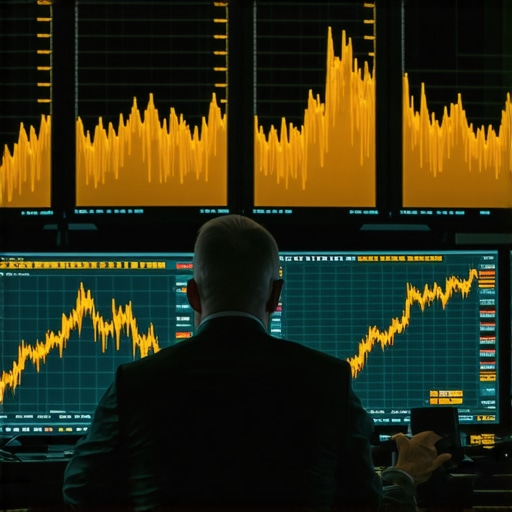Understanding Gold Futures: The Basics for New Investors
Gold futures are contracts that allow investors to buy or sell a specified amount of gold at a predetermined price on a specific date in the future. This trading method has become increasingly popular among both seasoned investors and newcomers looking to diversify their portfolios. Understanding how to navigate the complexities of gold futures can significantly enhance your investment strategy.
Investing in gold futures provides a unique opportunity to leverage your investment capital. Unlike physical gold, which requires significant upfront capital for purchase, futures contracts enable investors to control a large amount of gold for a relatively small upfront payment, known as margin. This aspect makes it an appealing option for those who want to maximize their potential returns while minimizing initial investment.
Key Advantages of Gold Futures
One of the primary advantages of trading gold futures is the liquidity they offer. Gold is one of the most actively traded commodities globally, providing investors with the ability to enter and exit positions quickly. Additionally, gold futures can serve as a hedge against inflation and economic instability, often increasing in value during times of market uncertainty.
Furthermore, gold futures allow for various strategies, from hedging against price declines to speculating on future price movements. These strategies can be particularly beneficial for investors looking to capitalize on market fluctuations. To deepen your understanding of these strategies, consider exploring Mastering Gold Investment Strategies: Tips for Beginners for insightful information.
How to Get Started with Gold Futures
For beginners, starting with gold futures involves a few essential steps. First, you should familiarize yourself with the mechanics of futures trading. This includes understanding terms like contract size, margin requirements, and expiration dates. Many educational resources are available, including How to Start Investing in Gold: A Newbie’s Guide, which offers detailed insights for new investors.
Next, selecting a reliable brokerage that supports futures trading is crucial. A good brokerage provides necessary tools and resources, such as market analysis, trading platforms, and customer support. After selecting a brokerage, you can begin to develop a trading plan outlining your investment goals, risk tolerance, and strategies for entering and exiting trades.
Risk Management in Gold Futures Trading
Like any investment, trading gold futures carries inherent risks. Price volatility can lead to significant gains or losses, making it essential to implement risk management strategies. Consider setting stop-loss orders to limit potential losses and regularly review your investment strategy to ensure it aligns with market conditions. For additional guidance on managing risk, check out Understanding the Risks of Gold Trading in Current Markets.
In conclusion, while gold futures present a complex trading environment, they offer significant opportunities for profit and portfolio diversification. By understanding the fundamentals, adopting effective strategies, and managing risks, beginners can navigate the gold futures market with confidence. As you embark on this investment journey, ensure you continually educate yourself, staying updated on market trends and insights.
Exploring the Benefits of Gold Futures Trading
Gold futures trading presents a compelling avenue for investors looking to tap into the potential of gold while minimizing upfront costs. One of the most appealing aspects of gold futures is their ability to provide exposure to gold prices without the need to purchase actual physical gold. This feature is particularly advantageous for those who may not have the capital to invest in gold bullion or coins directly.
Potential for High Returns with Gold Futures
Investors are often drawn to gold futures due to the potential for high returns. Since futures trading allows for leverage, traders can control larger positions with a smaller amount of capital. This means that even small price movements in gold can lead to significant profit or loss. To learn more about how to maximize your returns, consider reading Maximizing Returns with Smart Gold Trading Tips.
Hedging Against Economic Uncertainty
Gold is traditionally viewed as a safe-haven asset, especially during times of economic uncertainty. By investing in gold futures, traders can hedge their portfolios against potential downturns in the stock market or inflationary pressures. This strategy makes gold futures an essential tool for investors who want to maintain stability in their investment portfolios. For insights on how to navigate economic uncertainties through gold investments, check out Buying Gold During Economic Uncertainty: A Guide.
Flexibility in Trading Strategies
Gold futures trading also offers flexibility in terms of trading strategies. Investors can choose to take a long position if they anticipate rising gold prices or a short position if they expect a decline. This versatility allows traders to adapt to market conditions swiftly. Furthermore, implementing specific strategies, such as spread trading, can help manage risk effectively. To dive deeper into effective strategies, explore Top 10 Gold Investment Strategies You Should Follow.
The Role of Market Analysis in Gold Futures
Understanding market analysis is crucial for success in gold futures trading. Investors should be familiar with technical analysis and fundamental analysis to make informed decisions. Technical analysis involves studying price charts and patterns, while fundamental analysis focuses on economic indicators and geopolitical events that influence gold prices. For a comprehensive overview of market dynamics, consider visiting Understanding Gold Market Dynamics for Smart Investing.
Demystifying the Gold Futures Market
As a newcomer, it’s essential to demystify the gold futures market. Gaining knowledge about how contracts work, the significance of expiration dates, and the impact of global events on gold prices can empower you as an investor. Embracing continuous education and remaining informed about market trends is vital for long-term success. For beginner-friendly resources, check out Investing in Gold: A Beginner’s Essential Checklist.
In summary, gold futures trading offers numerous advantages, from leveraging investment capital to hedging against economic turbulence. By understanding the intricacies of the gold futures market and employing effective trading strategies, both novice and experienced investors can enhance their financial portfolios. As you engage in this exciting trading environment, leverage the wealth of knowledge available to make informed decisions and maximize your investment potential.
Key Trading Strategies for Gold Futures
To successfully navigate the gold futures market, it’s crucial to adopt effective trading strategies. One popular strategy is the trend-following approach, where traders analyze price movements and follow the prevailing direction of the market. This method can be particularly effective in a bullish market, where prices are consistently rising. For those interested in a more conservative approach, Top 10 Gold Investment Strategies You Should Follow offers valuable insights to minimize risks while maximizing returns.
Understanding Technical Indicators in Gold Futures
Utilizing technical indicators is essential for informed trading decisions. Indicators such as moving averages, Relative Strength Index (RSI), and Bollinger Bands can help traders identify entry and exit points. By combining these indicators with fundamental analysis, investors can gain a comprehensive understanding of market trends. For those looking to deepen their market analysis skills, consider reading Analyzing Gold Market Analysis: Essential Insights.
Risk Management Techniques for Gold Futures Traders
Effective risk management is critical in gold futures trading. Traders should implement stop-loss orders to minimize potential losses and protect their investments. Additionally, diversifying your portfolio by including various gold-related assets can help mitigate risks associated with market volatility. For a deeper understanding of how to protect your investments, check out How to Navigate Gold Demand: Essential Insights for 2025.
Market Trends Influencing Gold Futures
Various factors impact the gold futures market, making it vital for traders to stay informed about current trends. Economic indicators, such as inflation rates and employment data, can significantly influence gold prices. For instance, when inflation rises, investors often flock to gold as a hedge, driving prices up. To stay ahead of market fluctuations, consider exploring Gold Price Trends: How to Stay Ahead of the Market.
The Role of Geopolitical Events in Gold Pricing
Geopolitical tensions can also play a significant role in gold price fluctuations. Events such as elections, trade disputes, and conflicts often lead to increased demand for gold as a safe-haven asset. Understanding how these events affect market dynamics is essential for traders. For an in-depth look at how geopolitical factors influence gold pricing, read The Role of Central Banks in Gold Price Fluctuations.
Leveraging Market Sentiment in Gold Futures Trading
Market sentiment, or the overall attitude of investors toward a particular market, can significantly impact gold prices. Keeping an eye on news, social media, and investor forums can provide insights into prevailing sentiment. By gauging market sentiment, traders can make informed decisions about entering or exiting positions. For strategies on how to analyze market sentiment effectively, consider visiting Exploring the Basics of Gold Trading Techniques.
Identifying Optimal Entry and Exit Points in Gold Futures
Effective trading in gold futures requires a keen understanding of when to enter and exit positions. One common strategy is to utilize chart patterns to forecast potential price movements. Patterns such as head and shoulders, double tops, and flags can provide valuable insights for traders. To understand these patterns better, explore How to Spot Gold Price Fluctuations and Trends, which elaborates on identifying trends and making informed choices.
Utilizing Stop-Loss Orders for Protection
In the volatile world of gold futures, implementing stop-loss orders is essential for protecting your investments. By setting predefined exit points, traders can minimize losses if the market moves against them. This risk management tool not only safeguards your capital but also enables more disciplined trading. For comprehensive strategies on managing risk, refer to Essential Tips for Investing in Gold Futures.
Understanding Market Psychology in Gold Trading
Market psychology plays a crucial role in gold futures trading. The emotional responses of traders can lead to irrational market movements. Recognizing patterns of fear and greed can help traders anticipate price swings. By studying historical price movements alongside psychological indicators, you can gain a better understanding of market sentiment. For insights into leveraging market psychology, check out How Gold Prices Correlate to Global Events.
The Impact of Economic Data Releases on Gold Prices
Economic data releases, such as GDP growth and employment figures, can significantly impact gold prices. Traders should stay informed about upcoming announcements and their potential implications for the gold market. For instance, a strong jobs report may decrease gold prices as investors shift towards riskier assets. To stay ahead, consider reading Gold Price Trends: How to Stay Ahead of the Market, which provides strategies for anticipating market reactions to economic changes.
Long-Term vs. Short-Term Trading in Gold Futures
When it comes to gold futures, traders must decide between long-term and short-term trading strategies. Long-term traders often focus on macroeconomic factors and global market trends, while short-term traders may capitalize on daily price fluctuations. Each approach has its own set of advantages and challenges. If you’re interested in exploring the benefits of long-term investing, check out The Future of Gold Investments: Trends to Watch in 2025.
Choosing the Right Trading Platform for Gold Futures
Selecting an appropriate trading platform can also influence your success in gold futures. Look for platforms that offer advanced charting tools, real-time data, and a user-friendly interface. Additionally, ensure that they provide access to a variety of gold trading options, including futures contracts and options trading. For a comprehensive guide on trading platforms, visit Investing in Gold: A Comprehensive Overview for Newbies.
Frequently Asked Questions (FAQ) about Gold Futures Trading
What are gold futures?
Gold futures are contracts to buy or sell gold at a predetermined price on a specific date in the future. They are used by traders to hedge against price fluctuations or to speculate on future gold prices.
How do I start trading gold futures?
To start trading gold futures, you need to open a trading account with a brokerage that offers futures trading. Familiarize yourself with the market, develop a trading strategy, and consider practicing with a demo account before investing real money.
What factors influence gold prices?
Gold prices are influenced by various factors, including economic data releases, geopolitical events, inflation rates, and changes in currency values. Understanding these influences can help traders make informed decisions.
Is trading gold futures risky?
Yes, trading gold futures can be risky due to the volatile nature of the market. Prices can fluctuate significantly based on market sentiment and external factors. Implementing risk management strategies, such as stop-loss orders, can help mitigate these risks.
What is the difference between long-term and short-term gold futures trading?
Long-term trading focuses on macroeconomic trends and aims for substantial price movements over time, while short-term trading seeks to capitalize on daily price fluctuations. Each approach has its own strategies and risk profiles.
Can I trade gold futures on margin?
Yes, gold futures can be traded on margin, allowing traders to control a larger position with a smaller amount of capital. However, this increases the risk of significant losses, so it’s important to use margin wisely.
How can I analyze gold futures prices?
Traders can analyze gold futures prices using technical analysis, which involves studying chart patterns and indicators, or fundamental analysis, which looks at economic data and market news. Combining both methods can provide a comprehensive view.
What are the best strategies for trading gold futures?
Some effective strategies for trading gold futures include trend following, breakout trading, and using technical indicators such as moving averages and RSI. It’s crucial to adapt your strategy based on current market conditions.
How does inflation affect gold prices?
Gold is often viewed as a hedge against inflation. When inflation rises, the value of currency declines, leading investors to seek gold as a stable asset, which can drive up its price.
Where can I find reliable information about gold futures trading?
Reliable information can be found on trusted financial websites, trading platforms, and through educational resources like courses and webinars offered by experienced traders.
Authority Resources for Gold Futures Trading
For those looking to deepen their understanding of gold futures trading, the following authoritative resources can provide valuable insights:
- CME Group: Gold Futures & Options – A comprehensive source for gold futures contracts, market data, and educational resources.
- Investopedia: Gold Futures – Provides detailed explanations and articles on gold futures trading.
- Kitco News – A leading provider of precious metals news and market data, offering articles on market trends and analysis.
- BullionVault – An online platform for buying and selling gold, providing insights into gold investment strategies.
- World Gold Council – Offers research, data, and insights into gold markets and investment trends.
Conclusion
Trading gold futures presents both opportunities and challenges, requiring a clear understanding of market dynamics, trading strategies, and risk management. By leveraging the insights and resources provided in this guide, you can enhance your trading skills and make informed decisions in the gold futures market. Remember, whether you are a long-term investor or a short-term trader, the gold market can be a valuable addition to your trading portfolio.











This is such a comprehensive overview of gold futures for beginners. I appreciate how the article emphasizes not just the potential for high returns but also the importance of risk management. I remember initially being intrigued by the leverage aspect, but I soon realized that improper use could lead to significant losses. Setting up solid stop-loss strategies really helped me manage my positions better. One challenge I faced early on was understanding the right timing for entering or exiting trades, especially when market trends shift rapidly. I found that combining technical indicators with fundamental analysis increased my confidence in decision-making. For those just starting out, what are some common mistakes you’ve seen new traders make, and how can they avoid these pitfalls? I think continuous education and paper trading are key before risking real capital. It’s exciting to see how adaptable trading strategies are and how they can serve different risk tolerances. Would love to hear how others balance short-term gains versus long-term planning in gold futures trading.